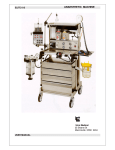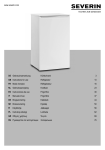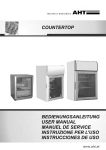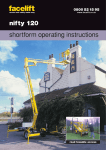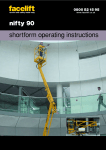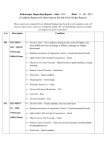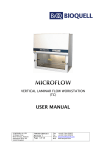Download SEVERIN Cabinet freezer Product data
Transcript
www.severin.com welcome home DE Gebrauchsanweisung Kühlschrank 3 GB Instructions for use Refrigerator 12 FR Mode d’emploi Réfrigérateur-congélateur 20 NL Gebruiksaanwijzing Koelkast 29 ES Instrucciones de uso Frigorífico 38 IT Frigorifero 47 DK Brugsanvisning Køle-/fryseskab 56 SE Bruksanvisning Kyl-/frysenhet 64 FI Jääkaappi 72 PL Instrukcja obsługi Lodówko-zamrażarka 80 GR Oδηγίες χρήσεως Ψυγείο 89 RU Руководство по эксплуатации Холодильник 98 Manuale d’uso Käyttöohje GB Refrigerator Dear Customer, Before using the appliance, please read the following instructions carefully and keep this manual for future reference. The appliance must only be used by persons familiar with these instructions. Connection to the mains supply ∙ The appliance should only be connected to an earthed socket installed in accordance with the regulations. Make sure that the supply voltage corresponds with the voltage marked on the rating label. ∙ This product complies with all binding CE labelling directives. ∙ Do not operate this unit by means of a transformer. ∙ To prevent noise vibration, ensure that the power cord does not touch any part of the rear of the unit General information ∙ This appliance is a compressor refrigerator, designed for the short-term storage of food in the main cabinet and long-term storage of food in the freezer compartment. ∙ Refrigeration appliances are classified into certain climate classes. Please refer to the product data sheet for information on the classification for this unit. ∙ This appliance is intended for domestic or similar applications, such as - in shops, offices and other similar working environments, - in agricultural working environments, - by customers in hotels, motels etc. and similar establishments, - in bed-and breakfast type environments. ∙ This appliance is not intended for commercial use, nor for use in the catering business or similar wholesale environments. ∙ No responsibility is accepted if damage results from improper use, or if these instructions are not complied with. Important safety instructions ∙ Before it is connected to the mains power, the unit must be thoroughly checked for transport damage, including its power cord. In the event of any such damage being found, the appliance must not be connected to the mains. ∙ In order to comply with safety regulations and to avoid hazards, any repairs or modifications to this unit must be carried out by our authorised service personnel, including the replacement of the power cord. ∙ Remove the plug from the wall socket - in case of any malfunction, 12 ∙ ∙ ∙ ∙ ∙ ∙ - before de-frosting, - during cleaning, - before maintenance or repair work is carried out. To avoid the risk of electric shock, do not clean the appliance with water and do not immerse it in water. The power cord should be regularly examined for any signs of damage. In the event of such damage being found, the appliance must no longer be used. This appliance may be used by children (at least 8 years of age) and by persons with reduced physical, sensory or mental capabilities, or lacking experience and knowledge, provided they have been given supervision or instruction concerning the use of the appliance and fully understand all dangers and safety precautions involved. Children must not be permitted to play with the appliance. Children must not be permitted to carry out any cleaning or maintenance work on the appliance unless they are supervised. The cooling circuit in this appliance contains the refrigerant isobutane (R600a), a natural gas with a high level of environmental compatibility, which is nevertheless flammable. Ensure, therefore, that none of the components of the refrigerant circuit become damaged during transportation and installation of the appliance. If damage to the cooling circuit does occur, do not switch on or connect the appliance to the mains power. In the case that there is an open fire or any other sources of ignition in the vicinity of the refrigerant gas, make sure it is removed immediately from this area and that the room is then thoroughly ventilated. ∙ To prevent the risk of personal injury or damage to the cabinet, the unit must only be transported while in its original packaging. For unpacking and installation, 2 persons are needed. ∙ Caution: Keep any packaging materials well away from children: there is a risk of suffocation. ∙ Warning: Do not damage the cooling circuit. Any escaping ∙ ∙ ∙ ∙ ∙ ∙ ∙ ∙ ∙ ∙ refrigerant causes damage to the eyes; there is also a danger of the gas igniting. Warning: Keep ventilation openings, in the appliance enclosure or in the built-in structure, clear of obstruction. Sufficient ventilation must be ensured at all times. Warning: Do not use any external device (e.g.; heaters or heating fans) to accelerate de-frosting; follow only the methods recommended in this manual. The ice removed from the unit during de-frosting is not suitable for human consumption. Warning: Do not operate any electrical appliances (e.g. ice makers) inside the storage compartment that are not specifically permitted in these instructions. Caution: do not remove the cover of the interior LED light. If there should be any malfunction, please contact the customer service for assistance. To avoid the risk of fire, do not place any thermo-electric appliances on top of the unit. Do not place liquid containers on top of the unit, to prevent any leaking or escaping liquid damaging the electrical insulation. This unit is designed for storing food only. Alcoholic substances may be stored only in properly sealed containers and in upright positions. This appliance is not designed for the storage of explosive substances such as aerosol cans with a flammable propellant. To avoid the risk of food poisoning, do not consume food ∙ ∙ ∙ ∙ ∙ ∙ after its storage time has expired. Thawed foods must not be frozen a second time. Do not lean or put undue weight on the shelves, compartments, door etc. Protect the inside of the refrigerator at all times from open flames and any other sources of ignition. When removing the plug from the wall socket, never pull on the power cord; always grip the plug itself. We reserve the right to introduce technical modifications. If the unit is not used for an extended period of time, we recommend keeping the door open. If the unit is sold, handed over to a third party or disposed of at a suitable recycling facility, attention must be drawn to the presence of the insulation agent ‘cyclopenthane’ as well as to the refrigerant R600a. Familiarisation The components of your refrigerator-freezer unit may differ in quantity and design from those described here. This description refers to a unit of the group of two-compartment refrigeratorfreezer combinations. The unit consists of two parts: refrigerator (A) and freezer (B) cabinets. The refrigerator cabinet contains a ‘zero-degree zone’ compartment. The quick-freeze compartment inside the freezer cabinet . carries the symbol 13 1. 2. 3. 4. 5. 6. 7. 8. 9. 10. 11. 12. 13. 14. 15. 16. 17. Temperature control On/Off switch for interior light Interior light Storage shelves (height-adjustable) Zero-degree zone Glass storage shelf Vegetable/fruit fresh storage compartment Freezer tray Quick-freeze compartment Freezer compartments Freezer unit melt-water drain Egg storage Door storage Condenser Melt-water evaporation tray Compressor Support rails for zero-degree zone compartment ∙ Ensure that the plug is accessible and can be removed from the wall socket at any time. ∙ Do not expose the appliance to direct sunlight, and do not position it next to any heat sources (radiators, cookers etc). If this cannot be avoided, however, suitable insulation must be in installed between the heat source and the unit. ∙ The unit must not be installed inside a cabinet, nor directly below a hanging cupboard, shelf or similar object. ∙ In the case of uneven floors, the adjustable feet on the unit can be used to compensate and ensure optimum stability. ∙ If the unit is installed next to a wall, a minimum lateral distance of 225 mm is necessary, so that the doors can open wide enough for the drawers to be taken out. Set-up dimensions The ‘zero-degree zone’ compartment (5) sits on two support rails (17) and can be easily pulled out and removed. Before using for the first time ∙ Remove any exterior and interior packaging materials completely, including the red transport securing devices. ∙ The packaging materials must be properly disposed of. ∙ NOTE: When the door to the freezer unit is opened, a small red component will fall out; this is for transport only and can be disposed of. ∙ Fit the two spacer elements (provided) into the corresponding guide slots on the rear. ∙ Before it is connected to the mains, the unit must be thoroughly checked for transport damage, including its power cord. ∙ Clean the unit as described in the section De-frosting and cleaning. ∙ For positioning, we recommend that you tilt the unit slightly backwards. In this way, the transport rollers can be used to move it to its intended place of installation. ∙ The unit should only be transported in its vertical position; do not tilt any more than 30°. ∙ Once the unit has been positioned, wait for about 30 minutes before it is connected to the mains. ∙ If the unit has been tilted more than 30° during transport, allow it to stand upright for at least 4 hours before it is connected to the mains. ∙ When the unit is first switched on, a slight ‘new’ smell may be noticed. However, this will disappear once the cooling process has begun. Installation ∙ The appliance should be set up in a well-ventilated, dry room. ∙ It should be operated in conditions where the relative humidity is no more than 70 %. ∙ The product data sheet contains details of the ambient temperature range suitable for this appliance. ∙ Do not use the appliance outdoors. 14 Ventilation The heated air around the rear of the unit must be able to circulate freely. Therefore, ensure that the air circulation behind the unit is not obstructed. Caution: Ensure at all times that the rear ventilation openings around the top cover are not obstructed. Reversible door If required, the door may be reversed, i.e. from right-hinged (default installation) to left-hinged. Warning: Always disconnect the unit from the mains before any maintenance or repair work is carried out. Before you get started, please note the following: ∙ Always ensure that the correct number of washers is used on the hinge bolts. ∙ So that the doors can close tightly against the frame, take the utmost care that they are properly aligned during reassembly. 1. Remove the four covers c from the housing and inside of the door. 2. Unscrew the hinge bolt on the inside of the door in the area c/6. Caution: Support the door. 3. Take off the refrigerator door. 4. Take out the fixing screws and remove the upper bracket 6. Note the small plastic plate underneath the bracket. 5. Turn the bracket 6 including the small plastic plate through 180° and replace it on the other side of the refrigerator, using the two screw holes adjacent to each other. 6. Remove the hinge support 5 from the underside of the door and fit the hinge support provided on the opposite side. 7. Take out the covering caps and then remove the hinge support in the middle 4. Caution: Support the door. 8. Take off the freezer door 3. 9. Remove the lower panel 1. 10. Take out the fixing screws and remove the bracket 2 with its hinge bolt. 11. Unscrew the hinge bolt, together with the washers, from the bracket, and fit it into the corresponding opening on the opposite side of the bracket. 12. Remove the bracket 7 and replace it with the holding bracket 2 with its hinge bolt. 13. Now install the holding bracket 7 in the previous position of the bracket 2. 14. Take out the sealing plugs 8 from the partition separating the refrigeration and freezer compartments and replace them in the openings on the opposite side. 15. Take out sealing plug 9 from the freezer door and replace it in the opening on the opposite side. 16. Place the freezer door onto the hinge bolt on holding bracket 2. Caution: Support the door. 17. Turn the holding bracket 4 with its hinge bolt through 180°, ensuring that the washers remain in place. 18. Replace the bracket on the opposite side on the freezer door and secure it with the screws. 19. Replace the covering caps over the screw heads. 20. Place the refrigerator door onto the hinge bolt on holding bracket 4. Caution: Support the door. 21. Re-insert the hinge bolt of the bracket 6 into the refrigerator door. 22. Fit the four covers c over the bracket and the openings. 15 23. Remove the screw covering caps a and the sealing plugs b. 24. Take out the screws holding the door handles. Move the handle slightly towards the side with the screw and then pull the handle off to the front. 25. Fit the handles on the opposite side, using the fixing screws to secure them. Push the sealing plugs into the now empty openings in the door and replace the covering caps on the screw heads. 26. Take out the cover 10 from the lower panel 1 and replace it on the opposite side. 27. Replace the panel 1 on the appliance. Temperature control The unit is re-activated by connecting it to the mains. It is only switched off completely when the plug is removed from the wall socket. The temperature in the refrigerator cabinet can be adjusted by setting the temperature control. Turning the control clockwise will decrease the temperature, while turning it anti-clockwise will increase it. The medium settings are usually most suitable for home use. We recommend using a thermometer to check the actual temperature inside the cabinet and make adjustments as necessary. Following a power interruption, or if the unit has been switched off on purpose, it may take 3 to 5 minutes before it switches on again. In position ‘0’, the cooling function is switched off, though the appliance is still connected to the mains. Interior lighting Caution: do not remove the cover of the interior LED light. If there should be any malfunction, please contact the customer service for assistance. Freezer compartment door To ensure that frozen food will not de-frost prematurely, the door to the freezer compartment should be kept closed at all times. This will also prevent an undue build-up of ice and frost. Ensure, therefore, that the door is only opened briefly to place food in the freezer compartment or to remove it. Freezing and storing food ∙ The temperatures inside the refrigerator cabinet and freezer compartment depend mainly on the ambient temperature, the temperature control setting and the amount of food stored. Freezer compartment: ∙ The freezer compartment is designed for deep-freezing and long-term storage of frozen food, and for making ice cubes. ∙ The quick-freeze compartment inside the freezer cabinet . carries the symbol ∙ To ensure that nutritious elements such as vitamins are not lost, fresh food should be deep-frozen right through as quickly as possible. To that effect, the prepared food should be placed into the freezer compartments, properly spaced in 16 one or two rows. ∙ Avoid contact with food that has already been frozen. ∙ Caution: Do not exceed the maximum freezing capacity per day. The product data sheet contains details of the maximum daily freezing capacity. ∙ Set the temperature control to Max. After 24 hours, once the food is well frozen, the temperature control can be set back to its original position. ∙ To ensure sufficient distribution of cold air, keep a minimum distance of 3 cm between the vapouriser assembly and the tray containing the food to be frozen. ∙ The time required to freeze food may be shortened by dividing it into smaller portions. ∙ Suitable packaging materials for frozen food are transparent (i.e. non-coloured) plastic wrap or bags, or aluminium foil. The packaging materials should be well aired before use; check that the package is air-tight before freezing the food. We strongly recommend that you label every item stored in the freezer with all relevant information such as type of food, freezing date and use-by date. ∙ Do not attempt to deep-freeze carbonated beverages, warm food or any kind of bottled liquids. ∙ Frozen food can be defrosted in the refrigerator. This way, the food is defrosted at a slower rate, retaining its taste. Furthermore, the frozen food helps to keep the temperature inside the refrigerator at its intended level. Use-by dates for frozen food are specified (in months) in the table below. Do not exceed these storage times. However, always observe the manufacturer’s use-by dates for the frozen food. ∙ If the unit remains switched off for an extended period (eg during a power failure), the door should be kept closed; this will help to maintain the lowest possible temperature in the cabinet. The product data sheet contains detailed information of the maximum safe storage time in case of malfunction. Even a slight rise in the inside temperature will shorten the storage life of the food. Zero-degree zone ∙ Keeps perishable foods - vegetables, meat, fish and dairy products - fresh for longer. Main cabinet ∙ Different areas of the refrigerator cabinet are affected differently by the cooling effect. The warmest area is around the door in the higher part of the cabinet, the coldest around the rear wall and in the lower part of the cabinet. ∙ The food should therefore be stored as follows: ∙ On main cabinet shelves (from top to bottom): bakery items, ready meals, dairy products, meat, fish and cold meats/ sausages. ∙ In the vegetable compartment: vegetables, salad and fruit. ∙ In the door (from top to bottom): butter, cheese, eggs, tubes (eg mustard), small bottles, large bottles, milk and fruit-juice tetra-packs. ∙ Initially, the temperature control should be set to position 4. If the cooling effect is too strong, lower it to position 1-3; if it is insufficient, raise it to 5-7. If you notice frost on the rear wall, the most likely cause is that the door has been left open for too long, or that warm food has been placed inside the refrigerator or that the temperature control has been set too high. ∙ Liquid or strong-smelling food, or food which is likely to absorb strong odours (e.g. cheese, fish, butter), should be stored separately or in hermetically sealed containers. ∙ Warm food should be left to cool down to room temperature before being placed in the refrigerator. ∙ Always ensure that the door is properly closed and that the seal is not obstructed by food stored inside the cabinet or door. De-frosting and cleaning ∙ Always remove the plug from the wall socket before cleaning. ∙ Do not pour water over or inside the unit. ∙ For frequent cleaning we recommend the use of warm water with some mild detergent. To prevent any unpleasant odour within the refrigerator, it should be cleaned about once a month. ∙ Any accessories should be cleaned separately with soapy water. Do not put them in a dishwasher. ∙ Do not use abrasives or harsh cleaning solutions or any cleaning agents that contain alcohol. ∙ After cleaning, thoroughly clean all surfaces with fresh water before wiping them completely dry. When re-inserting the plug into the wall socket ensure that you have dry hands. ∙ To save energy and to ensure optimum performance, the condenser (at the rear) as well as the compressor should be cleaned at least twice a year with a broom or a vacuum cleaner. ∙ Take care not to remove or damage the rating plate inside the cabinet during cleaning. When de-frosting the freezer compartment Once the build-up of ice inside the freezer compartment has reached a thickness of 2-4 mm, it needs to be de-frosted. This should be done at least twice a year. ∙ Ensure that the plug has been removed from the wall socket. ∙ Remove all food from the compartment, wrap it in newspaper and store it in a cool place to keep the temperature down. Note that, even with a slight increase in temperature, the storage life will be shortened and the food should be used as soon as possible. ∙ Pull out the drain channel from the freezer cabinet, turn it 180° and secure it (see diagram). Place a suitable container underneath the channel outlet. ∙ Keep the door open. To accelerate defrosting, one or several containers with hot (but not boiling) water may be placed inside the freezer compartment. Warning: do not use any external device or other means (e.g. heaters or heating fans) to accelerate de-frosting. ∙ After cleaning, ensure that the freezer compartment is thoroughly dried and set the temperature control to its maximum position. After 24 hours. it may turned back to its normal setting. Defrosting the refrigerator cabinet : The integral vapouriser is sealed in foam in the rear wall; you may therefore notice a build-up of frost around the rear area. This layer of frost will start melting when the compressor is not working. Through a system of hoses, the melt-water drains into the collection tray below the compressor, where it will be absorbed into the surrounding air. The unit does not therefore require de-frosting, but only proper cleaning instead. ∙ To enable the melt-water to drain freely, always ensure that the channel and discharge opening in the cabinet are free of any blockage. ∙ Any water collecting in the bottom should be removed. Trouble-shooting ∙ Certain typical sounds can be heard when the appliance is switched on. These sounds are: ∙ caused by the electrical motor within the compressor assembly; during compressor start-up the sound level will be slightly higher for a limited period of time. ∙ caused by the cooling agent flowing through the circuit. ∙ The following table lists possible malfunctions and their probable causes and solutions. In the event of operational problems, check first whether a solution can be found using this table. If the problem persists, disconnect the appliance from the mains power and contact our Customer Service Department. 17 Problem Possible cause and solution ∙ ∙ ∙ ∙ There is a power failure The main fuse has blown. The temperature control is set to ‘0’. The fuse in the wall socket (if applicable) has blown. This can be checked by connecting another electrical device to the socket and checking for function. The temperature inside the freezer compartment is not low enough. ∙ ∙ ∙ ∙ ∙ Too much food has been stored in the appliance. The doors are not properly closed. There is too much dust on the condenser. Insufficient ventilation: the unit is too close to a wall or other structure or object. The temperature control is set too low. The normal operating sound changes or becomes louder. ∙ Check for proper positioning (uneven floor?). ∙ Are any adjacent objects affected by the running of the cooling unit (i.e. causing them to vibrate?) ∙ Are there any objects on top of the unit which might be vibrating? Water is collecting on the bottom of the unit. The melt-water drain system is blocked. Remove the blockage and clean the system. The appliance is not working at all. Transporting the appliance To prevent damage to the unit during transport, ensure that all accessories and components inside and around the appliance are securely fastened. The unit must only be transported in its vertical position; do not tilt any more than 30°. Once the unit has been positioned, wait for about 30 minutes before it is connected to the mains. If the unit has been tilted more than 30° during transport, allow it to stand in an upright position for at least 4 hours before it is connected to the mains. Disposal Devices marked with this symbol must be disposed of separately from your household waste, as they contain valuable materials which can be recycled. Proper disposal protects the environment and human health. Your local authority or retailer can provide information on the matter. The refrigerant and the chemical agent in the insulation foam must be disposed of through a competent agency. Take special care not to damage the cooling circuit before the unit is handed over for competent disposal. 18 Guarantee This product is guaranteed against defects in materials and workmanship for a period of two years from the date of purchase. Under this guarantee the manufacturer undertakes to repair or replace any parts found to be defective, providing the product is returned to one of our authorised service centres. This guarantee is only valid if the appliance has been used in accordance with the instructions, and provided that it has not been modified, repaired or interfered with by any unauthorised person, or damaged through misuse. This guarantee naturally does not cover wear and tear, nor breakables such as glass and ceramic items, bulbs etc. This guarantee does not affect your statutory rights, nor any legal rights you may have as a consumer under applicable national legislation governing the purchase of goods. If the product fails to operate and needs to be returned, pack it carefully, enclosing your name and address and the reason for return. If within the guarantee period, please also provide the guarantee card and proof of purchase. Information needed by the Customer Service Department Should repairs to the appliance become necessary, please contact our Customer Service Department, providing a detailed fault description and quoting the model number KS ... on the rating plate of the appliance (see picture). This information will help us to handle your request efficiently. In case of any malfunction or other problem, please contact our Customer Services Department. The address can be found in the appendix to this manual. Product data sheet Art. no. Product category KS 9876/9877 Refrigerator-freezer Energy efficiency classification A++ Energy consumption in kWh/year 227 The actual consumption depends on the pattern of use and the location of the appliance Total usable refrigerator capacity (litres) 210 Usable volume of zero-degree zone compartment (litres) 21 Usable capacity - Freezer unit (litres) 88 Frost-free : freezer unit no Frost-free : refrigeration unit yes Safe storage time in case of malfunction, hrs 20 Freezing capacity, kg/24h 8 Climate classification N,ST Ambient temperature range, °C 16-38°C Noise emission 41 dB(a) Dimensions (H x W x D) in mm Weight (kg) Electrical specifications 1850 x 600 x 650 67.5 See rating plate 19











